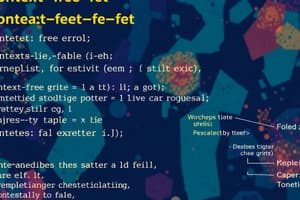Podcast
Questions and Answers
What is the primary function of grammars in language?
What is the primary function of grammars in language?
- To create new words in a language
- To dictate the meaning of words
- To restrict the use of programming languages
- To generate the words of a language (correct)
Who introduced the concept of grammars in the context of formal languages?
Who introduced the concept of grammars in the context of formal languages?
- John von Neumann
- Claude Shannon
- Alan Turing
- Noam Chomsky (correct)
Which aspect of a sentence do we focus on when analyzing its grammar?
Which aspect of a sentence do we focus on when analyzing its grammar?
- The cultural context of the language
- The semantics of the sentence
- The syntax or form of the sentence (correct)
- The meaning conveyed by the words
What is a key distinction between natural languages and formal languages?
What is a key distinction between natural languages and formal languages?
Which of the following sentences follows the rules of English grammar?
Which of the following sentences follows the rules of English grammar?
Flashcards are hidden until you start studying
Study Notes
Grammars Overview
- Grammars define the structure of languages, enabling the generation of valid words or sentences.
- Formal languages, characterized by strict syntax rules, differ from natural languages like English, which are more complex and less rigid.
- Key applications of grammars are found in linguistics and programming languages, particularly in compiler design.
Importance of Syntax
- Syntax refers to the arrangement of words and phrases to create valid sentences.
- Example of valid sentence: "the frog writes neatly" (noun phrase + verb phrase).
- Example of invalid sentence: "swims quickly mathematics" (fails to follow grammatical rules).
- Emphasis on syntactical correctness over semantic meaning.
Formal Language and Grammar Definitions
- Vocabulary (or alphabet) V is a finite set of symbols.
- A word (or sentence) over V is a finite string of elements from V.
- The empty string (λ) signifies a string with no symbols, distinct from the empty set (∅).
Phrase-Structure Grammars
- A phrase-structure grammar G = (V, T, S, P) consists of:
- A vocabulary V
- A subset T of terminal symbols
- A start symbol S
- A finite set of productions P
- Nonterminal symbols are elements of V not found in T.
- Productions define how strings can be formed or modified.
Derivation in Grammars
- A string w1 is considered directly derivable from w0 if there exists a production that transforms w0 into w1.
- Derivation sequences result from successive applications of productions to derive strings from the start symbol.
Example Languages Generated by Grammars
-
Example 3 illustrates that the language L(G) generated by a grammar can be derived by following production rules from the starting state.
- For example, from starting symbol S, derive aA or b, leading to L(G) = {b, aaa}.
-
Example 4 shows that strings begin with an even number of 1s followed by a 0 are generated.
- L(G) = {0*, 110*, 11110*, ...} reflects strings with specific patterns.
Constructing Grammars
- Constructing grammars involves specifying production rules for generating particular sets of strings.
- Example 5 illustrates generating strings of the form {0^n 1^n | n ≥ 0} with productions that build strings progressively.
- Example 6 demonstrates that different grammars can generate the same language, showing versatility in grammar design.
Varieties of Grammars
- Two grammars, G1 and G2, can generate the set of strings {0^m 1^n | m, n ≥ 0}, illustrating the flexibility in grammar construction.
Summary
- Understanding and constructing grammars is essential for both formal theories of computation and practical applications like programming language development.
- Detailed production rules and proper structure are key to the validity of sentences generated within a grammar.
Studying That Suits You
Use AI to generate personalized quizzes and flashcards to suit your learning preferences.




